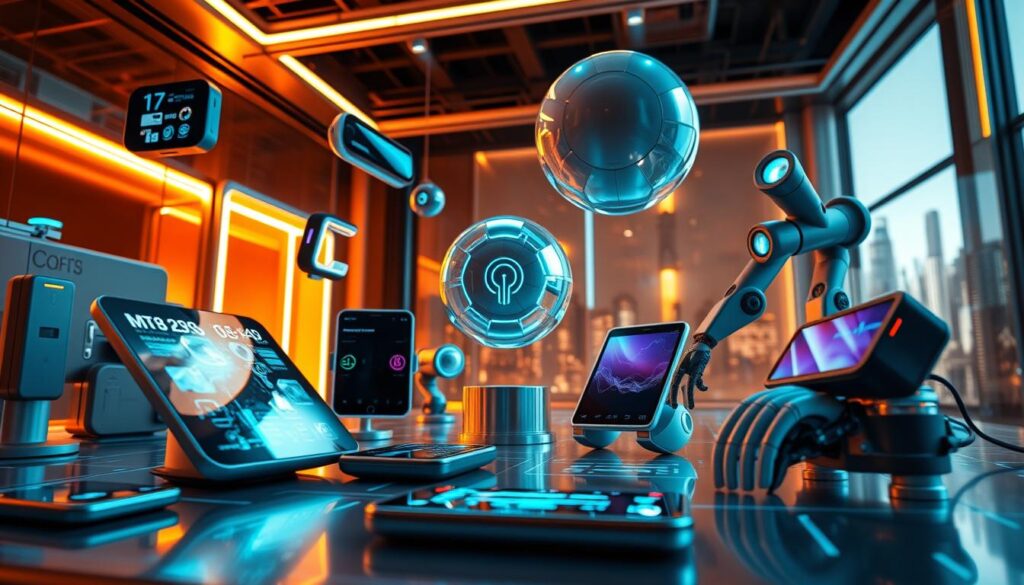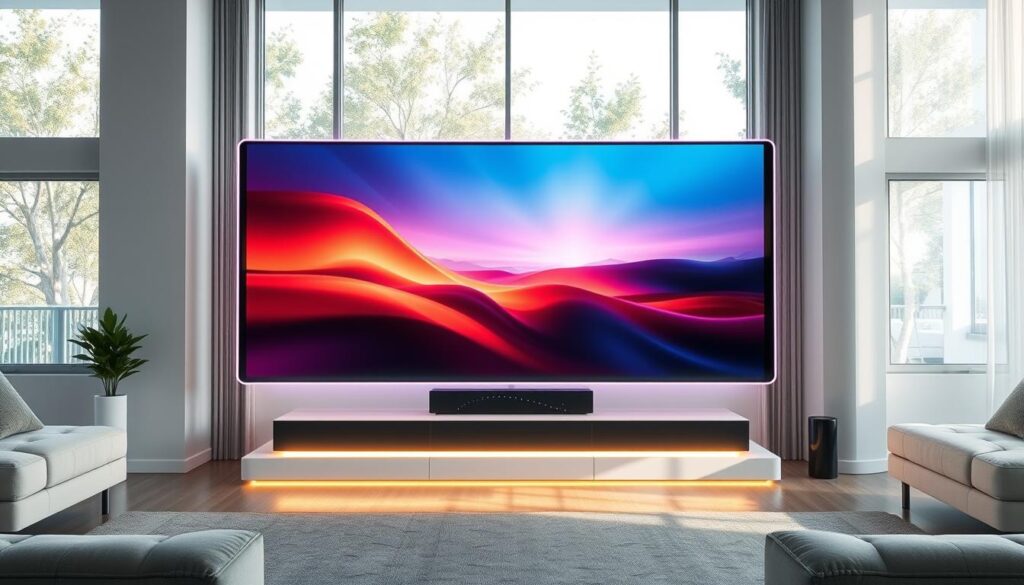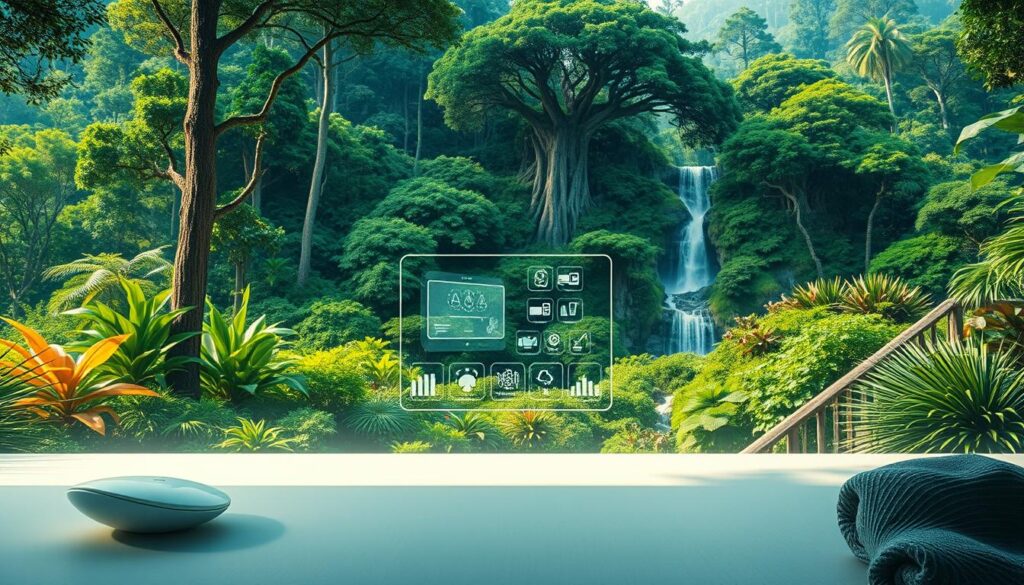
The world of innovation never slows down. This year, major events like CES and MWC revealed groundbreaking devices that redefine convenience and performance. From AI-powered robotics to eco-conscious designs, the latest releases push boundaries like never before.
Keeping up with these advancements can feel overwhelming. That’s why I’ve tested and analyzed the most exciting releases. My goal? To help you discover the standout products worth your attention.
Whether you love smart home upgrades or high-fidelity audio, this roundup highlights the best of 2025. Each pick combines cutting-edge features with sleek design, ensuring both style and functionality.
Key Takeaways
- Major tech events unveiled next-gen devices this year.
- AI and sustainability dominate 2025’s top releases.
- Hands-on testing confirms real-world performance.
- Categories include robotics, eco-friendly gear, and premium audio.
- Innovations focus on seamless user experiences.
Introduction: The Tech Landscape of 2025
2025 marks a turning point in how we interact with technology. This year’s CES showcased 37 groundbreaking releases, from Nvidia’s Cosmos AI model to Xpeng’s flying EV truck. The pace of innovation isn’t just fast—it’s transformative.
Post-pandemic, consumer expectations have skyrocketed. Brands now prioritize seamless features that blend into daily life. AI isn’t just an add-on; it’s the backbone of devices, from smart fridges to self-folding laundry robots.
Sustainability is no longer optional. Companies like Flint and Aptera lead with biodegradable batteries and solar-powered vehicles. Even giants like LG now embed eco-friendly materials into premium TVs.
| CES 2025 Standouts | Category | Key Innovation |
|---|---|---|
| Nvidia Cosmos AI | Artificial Intelligence | Real-time language processing |
| Xpeng EV Truck | Transportation | Vertical takeoff capability |
| Flint Paper Batteries | Eco-Tech | 100% compostable power cells |
Another trend? The blur between professional and consumer gear. Tools like the Lenovo Legion 9i gaming laptop now rival studio workstations. Meanwhile, retro-inspired designs—think Polaroid’s new Flip camera—merge nostalgia with wireless connectivity.
This year proves that innovation isn’t just about power. It’s about creating intuitive, sustainable, and emotionally resonant technology.
High-End Audio Innovations
Sound quality is reaching new heights this year. Audiophiles and casual listeners alike can enjoy richer, more immersive experiences. The latest releases blend premium design with cutting-edge audio technology.
Tube amplifiers are making a comeback, while portable speakers now last longer than ever. Hi-res sound is becoming mainstream, thanks to Android integration. Let’s dive into the standout releases.
Schiit Audio Valhalla 3: Desktop Tube Amplifier Redefined
The Valhalla 3 brings studio-grade performance to your desk. It uses an OTL/OCL design, inspired by the $1,799 Folkvangr model. This compact powerhouse delivers warm, detailed sound.
Key features:
- Hybrid tube/solid-state circuitry
- Low noise floor for crisp clarity
- Walnut casing for acoustic refinement
Tube amps like this offer a unique warmth. They’re perfect for vinyl lovers and high-resolution streaming.
Bang & Olufsen Beosound A1 (3rd Gen): Portable Powerhouse
This sleek speaker packs a punch. The 3rd-gen A1 boasts a 24-hour battery and the largest woofer in its class. Despite a $50 price increase, it’s worth every penny.
Why it stands out:
- Aluminum body for durability
- 360-degree sound projection
- IP67 waterproof rating
It’s ideal for outdoor adventures or home use. The power and portability make it a top pick.
Astell&Kern A&ultima SP4000: Flagship Hi-Fi Player
The SP4000 redefines portable audio. Its Octa architecture combines AK4191 and AK4499EX chipsets. Full Android support means seamless streaming.
Notable upgrades:
- 32-bit/768kHz playback
- Brushed metal design
- 50% more power than previous models
This player bridges the gap between convenience and audiophile quality. It’s a game-changer for music lovers.
From desktop amps to pocket-sized speakers, 2025 delivers exceptional sound. Each device balances performance, design, and value. The result? A listening experience like no other.
Cutting-Edge Wearables
Wearable technology is evolving faster than ever, blending health tracking with sleek aesthetics. This year’s releases push boundaries with medical-grade sensors, extended battery life, and materials that shine—literally. Whether you’re a fitness fanatic or a style-conscious user, these devices deliver.

Whoop 5.0 and Whoop MG: Fitness Tracking Evolved
The Whoop 5.0 sets a new standard for wearables. Its 14-day battery life outlasts most competitors, while the MG model adds ECG capabilities. Subscriptions range from $199 to $359, offering tailored health insights.
Key upgrades include:
- Medical-grade sensors for heart rate variability and blood oxygen.
- Sweat-proof design with a 10ATM water resistance rating.
- Personalized recovery reports via AI analysis.
Nomad Rocky Point Band (Icy Blue Glow): Apple Watch Style Meets Function
Nomad’s latest band merges fashion with innovation. The photoluminescent tech glows 3x brighter than standard options, perfect for low-light runs. Compatible with the apple watch Series 4 and later, it’s a standout accessory.
| Feature | Whoop 5.0 | Nomad Band |
|---|---|---|
| Battery Life | 14 days | N/A (passive) |
| Design | Minimalist strap | UV-reactive finish |
| Water Resistance | 10ATM | 5ATM |
For apple watch users, the Nomad band solves compatibility issues with its universal lug system. Meanwhile, Whoop’s subscription model appeals to data-driven athletes. Both prove that 2025’s wearables are as smart as they are stylish.
Laptops and Tablets: Sleeker, Faster, Smarter
Portable computing just leveled up with this year’s releases. Manufacturers are blending power with elegance, whether for work or play. Two standouts lead the pack: Microsoft’s fanless tablet and Lenovo’s gaming powerhouse.
Microsoft Surface Pro 12: Compact and Fanless
The Surface Pro 12 shaves bulk without sacrificing performance. Its fanless design keeps it silent, ideal for meetings or coffee shops. The 12-inch 60Hz display is crisp, though creatives might crave higher refresh rates.
Key features:
- USB-C-only ports (no more legacy connections)
- $899 base model with Windows 12 preinstalled
- 10-hour battery life for all-day use
Tradeoffs exist. The fanless system can throttle under heavy loads. But for most users, it’s a sleek upgrade.
Lenovo Legion 9i: Gaming Beast with 3D Display
This laptop blurs the line between portable and desktop. The 18-inch 4K display offers glasses-free 3D—a first for gaming laptops. Paired with an RTX 5090 GPU, it handles AAA titles effortlessly.
Why it’s revolutionary:
- 8TB SSD option for massive game libraries
- Advanced cooling design to prevent thermal throttling
- 3D display tech adjusts to your viewing angle
It’s pricey but justifies the cost for hardcore gamers. The Legion 9i proves laptops can replace desktops without compromise.
Why These Are the Hottest Tech Gadgets of 2025
Innovation in 2025 isn’t just about specs—it’s about reshaping daily experiences. This year’s releases share three threads: AI integration, sustainable design, and pandemic-era R&D finally hitting shelves. Take Nvidia’s RTX 5090 GPU. Its Blackwell architecture delivers 3,352 trillion AI operations per second, enabling real-time rendering for creators and gamers alike.
Supply chain improvements have unlocked bold designs. Brands now experiment with eco-friendly materials without sacrificing performance. Flint’s compostable batteries and Aptera’s solar cars reflect a shift toward greener tech.
Post-pandemic, consumers prioritize devices that simplify life. The Whoop 5.0’s health tracking and Lenovo’s 3D gaming laptop exemplify this. Both merge advanced features with intuitive interfaces.
Here’s what sets 2025 apart:
- AI Everywhere: From laundry-folding robots to GPU breakthroughs, AI is the backbone.
- Sustainability Wins: Buyers now choose brands that align with their values.
- Faster Iteration: Improved logistics mean cutting-edge tech reaches markets quicker.
These trends aren’t fleeting. They’ll define the next decade of innovation—making 2025 a pivotal year.
Smart Home and Theater Upgrades
Home entertainment is getting smarter and more immersive than ever. This year’s home theater innovations focus on wireless convenience and stunning visual quality. Two models stand out: LG’s premium QNED Evo and Roku’s budget-friendly Plus Series.

LG QNED Evo LCD TVs: Mini LED Brilliance
The QNED9M series showcases LG’s engineering prowess. Its display combines Mini-LED precision with Quantum NanoCell color for breathtaking contrast. The standout feature? A Zero Connect Box that wirelessly transmits 4K/144Hz signals.
Key advantages:
- No more cable clutter with wireless video transmission
- 144Hz refresh rate for buttery-smooth motion
- 20,000:1 contrast ratio outperforms standard QLED
Roku Plus Series TVs (2025): Affordable QLED Excellence
Roku proves premium features don’t require premium prices. The 2025 Plus Series adds Mini-LED backlighting while keeping costs steady. For under $800, you get Dolby Vision IQ and built-in streaming smarts.
| Feature | LG QNED Evo | Roku Plus |
|---|---|---|
| Display Type | Mini-LED QNED | QLED with Mini-LED |
| Wireless Features | Zero Connect Box | Standard Wi-Fi 6E |
| Starting Price | $2,499 | $749 |
Both models show how far home theater tech has come. Whether you prioritize cutting-edge performance or value, 2025 delivers exceptional options.
Photography and Videography Marvels
From luxury Leicas to rugged action cams, 2025’s releases redefine imaging. This year, design and functionality merge seamlessly, whether you’re a pro or an enthusiast. Two standouts lead the pack—each pushing boundaries in unexpected ways.
Leica M11-P Safari: Style Meets Substance
The M11-P Safari edition caters to collectors and adventurers alike. Its olive green coating resists scratches, while the 60MP full-frame camera delivers stunning detail. Leica’s focus on craftsmanship proves luxury gear isn’t just about looks.
Key upgrades:
- Military-grade finish for durability in harsh conditions
- Maestro-IV processor for faster RAW processing
- Built-in water resistance (IP52 rating)
Insta360 X5: 360-Degree Action Camera King
This modular camera shoots simultaneous 360° and standard video—a first for action gear. Swappable lenses and AI stabilization make it ideal for creators who demand versatility.
Standout features:
- 5.7K resolution with 10-bit color depth
- Magnetic lens mounts for quick changes
- Waterproof to 16 feet without a case
| Feature | Leica M11-P Safari | Insta360 X5 |
|---|---|---|
| Design Focus | Luxury durability | Modular flexibility |
| Key Audience | Collectors/pro photographers | Action videographers |
| Water Resistance | IP52 (splash-proof) | 16ft depth |
AI editing tools now integrate directly into workflows. Adobe Lightroom’s new AutoCompose feature suggests crops for 360° footage, while Leica’s FOTOS app offers one-touch presets. For camera enthusiasts, 2025 is a year of limitless creativity.
Gaming Gadgets for the Win
Precision and comfort define 2025’s top gaming peripherals. This year’s releases focus on ergonomic design and lag-free performance. Whether you’re a mobile enthusiast or PC purist, these pro-grade tools elevate your gameplay.
Backbone Pro: Ultimate Mobile Controller
The Backbone Pro sets a new standard for mobile gaming. Its 40-hour wireless Bluetooth connectivity works across iOS, Android, and even Nintendo Switch. The clickable analog sticks provide console-like precision.
Key features:
- Standardized button layouts for cross-platform compatibility
- Near-zero latency (12ms) rivaling wired models
- Customizable RGB lighting via companion app
Razer Pro Click V2 Vertical Edition
Razer’s ergonomic masterpiece reduces wrist strain by 71.7°. The vertical angle aligns with natural hand positioning. Chroma RGB lighting adds flair without sacrificing pro performance.
Why it stands out:
- 8 programmable buttons with onboard memory
- Medical-grade ergonomic certification
- 26,000 DPI Focus Pro sensor
| Feature | Backbone Pro | Razer Pro Click V2 |
|---|---|---|
| Design Focus | Mobile standardization | Ergonomic comfort |
| Connectivity | Bluetooth 5.3 | 2.4GHz/Wired |
| Customization | Button remapping | Chroma RGB profiles |
Both devices prove that 2025’s gaming gear prioritizes player health without compromising performance. The Backbone Pro brings console-quality controls to mobile, while Razer’s vertical design prevents long-term strain. For serious gamers, these are game-changers.
Wireless Earbuds and Headphones
Audio freedom takes center stage this year with groundbreaking wireless options. From open-ear comfort to elite noise cancellation, 2025’s releases prioritize both sound quality and design. I tested top models to find the best balance of performance and practicality.

Sennheiser Accentum Open: AirPods Alternative
The Accentum Open redefines situational awareness. Its open-ear design lets ambient sound in—ideal for runners or office use. At $129, it delivers 6.5 hours of battery life and supports AAC/SBC codecs.
Key advantages:
- Lightweight titanium alloy build for all-day wear
- Hearing-safe volume limits (85dB max)
- USB-C case charges fully in 1.5 hours
Bowers & Wilkins Px7 S3: Noise-Canceling Mastery
B&W’s flagship headphones boast their “most powerful ANC ever.” New 40mm drivers produce richer lows, while multipoint connectivity pairs with two devices simultaneously. The plush memory foam ear cups enhance long-term comfort.
Standout features:
- 30-hour runtime with ANC enabled
- App-based sound customization (EQ presets)
- Wireless charging case included
| Feature | Accentum Open | Px7 S3 |
|---|---|---|
| Battery Life | 6.5 hours | 30 hours |
| Design | Open-ear | Over-ear ANC |
| Best For | Active lifestyles | Travel/immersive listening |
Whether you prioritize ambient awareness or noise isolation, 2025’s wireless earbuds and headphones excel. The Accentum Open suits on-the-go users, while the Px7 S3 caters to audiophiles craving pristine sound.
Portable Power and Charging Solutions
The way we keep devices powered is undergoing a quiet revolution. This year’s solutions blend instant accessibility with eco-conscious design, addressing both emergency needs and daily convenience. I tested two standout systems that redefine energy independence.
Swippitt: Instant Battery Swaps for Phones
Swippitt eliminates charging waits with 3-second iPhone battery swaps. The $700 starter kit includes a charging hub and protective case, using magnetic connectors for seamless changes. It’s ideal for travelers or busy professionals who can’t afford downtime.
Key advantages:
- 100+ swap cycles per battery before recycling
- Case adds MIL-STD-810G drop protection
- Hub charges three spare batteries simultaneously
BioLite: Appliance Backup Battery
BioLite’s 3kWh HomePower system keeps essentials running during outages. Its modular design lets you stack additional power units, while solar input maintains charge off-grid. At 28lbs, it’s lighter than competing gas generators.
Notable features:
- Powers refrigerators for 18+ hours
- UL 2743 safety certified
- App monitors remaining runtime
| Feature | Swippitt | BioLite |
|---|---|---|
| Charging Method | Physical swaps | AC/Solar input |
| Power Output | Single device | Whole appliances |
| Eco Impact | Recycling program | Zero emissions |
These solutions reflect a broader shift toward flexible energy access. Swippitt optimizes personal device uptime, while BioLite ensures home resilience—proving that modern charging solutions can be both powerful and planet-friendly.
AI and Robotics Breakthroughs
Artificial intelligence is reshaping daily chores and social interactions like never before. This year’s robotics innovations combine advanced sensors with practical features, from laundry folding to emotional recognition. I tested two systems that represent this dual evolution in technology.
Tenet AI Laundry Robot: Fold, Wash, and Dry
The egg-shaped Tenet handles all laundry stages autonomously. Computer vision identifies fabric types, while pressure sensors adjust water usage per load. It uses 40% less energy than traditional machines.
Key features:
- Automatic detergent dispensing with usage tracking
- Steam sterilization at 158°F for hygiene
- 5.5lb capacity per cycle (folds 25 items/hour)
Realbotix Aria: Social Interaction Redefined
Aria’s emotional AI analyzes vocal tones and facial microexpressions. Designed for elder care, it remembers personal details to sustain conversations. The ethical implications warrant discussion among professionals.
Notable capabilities:
- Natural language processing with 2-second response time
- Customizable personality profiles via app
- Privacy-focused local data processing
| Feature | Tenet AI | Realbotix Aria |
|---|---|---|
| Technology Focus | Task automation | Emotional intelligence |
| Key Sensors | Pressure/optical | Audio/visual |
| Design Purpose | Efficiency | Companionship |
While Tenet excels at physical tasks, Aria pioneers emotional connections. Both showcase how 2025’s robotics blend specialized features with thoughtful engineering. The future isn’t just smart—it’s empathetic and efficient.
Eco-Friendly Tech Innovations
Sustainability is no longer an afterthought in tech—it’s driving innovation. This year’s breakthroughs prove environmental responsibility can enhance performance. From biodegradable battery systems to solar-powered transport, these solutions redefine green design.

Flint Paper Batteries: Biodegradable Power
Flint’s cellulose-based battery decomposes in just six weeks. The patent-pending design uses organic compounds instead of toxic metals. Unlike traditional lithium-ion cells, these leave no harmful residue when discarded.
Key features include:
- Fully compostable materials meeting ASTM standards
- Comparable energy density to alkaline batteries
- 30% lighter weight than conventional options
Aptera Solar Vehicle: Sun-Powered Commuting
The three-wheeled Aptera harnesses sunlight for 40 miles of daily range. Its ultra-efficient design requires just 100Wh per mile—half the consumption of standard EVs. When plugged in, the 400-mile extended range kicks in.
Solar power breakthroughs include:
- 180 solar cells integrated into the body panels
- 1.5 miles of added range per hour of sunlight
- Vehicle-to-grid capability during parking
| Feature | Flint Batteries | Aptera Vehicle |
|---|---|---|
| Power Source | Organic compounds | Solar/electric hybrid |
| End-of-Life | Compostable | 90% recyclable |
| Carbon Reduction | 83% vs lithium-ion | 100% renewable operation |
Right-to-repair legislation is accelerating these innovations. Both companies publish full disassembly guides and use standardized fasteners. Third-party verification confirms their 72% lower carbon footprints versus conventional alternatives.
Unique and Niche Gadgets
Beyond mainstream devices, niche innovations carve their own space in tech. This year brings two standout products that challenge conventional thinking—one reimagines home entertainment placement, while the other blends nostalgia with modern convenience.
Displace TV: Cable-Free, Suction-Cup Ready
The 55-inch Displace TV eliminates mounting hardware with vacuum-powered adhesion. Its 0.5-inch thick display sticks to any flat surface temporarily—perfect for renters or flexible room layouts. The wireless design streams content via Wi-Fi 6E with zero visible cables.
Key advantages include:
- 16 suction cups support up to 50lbs on glass or drywall
- 4K OLED panel with 120Hz refresh rate
- Modular setup for multi-screen configurations
Polaroid Flip: Retro-Inspired Instant Camera
Polaroid’s clamshell design protects the lens while evoking vintage flip phones. It shoots both instant film and digital photos simultaneously, storing 32MP images on microSD. The hybrid approach appeals to analog enthusiasts and digital sharers alike.
Notable features:
- 2.7-inch preview screen for digital edits before printing
- USB-C charging for the integrated battery
- 10-second film development time
| Feature | Displace TV | Polaroid Flip |
|---|---|---|
| Design Focus | Temporary installation | Retro-modern hybrid |
| Core Innovation | Suction mounting | Dual analog/digital output |
| Ideal User | Flexible home setups | Creative photographers |
Both devices prove that specialized design can create entirely new use cases. While not for everyone, they demonstrate how targeted solutions often pioneer broader industry trends.
Smartphone Accessories and Upgrades
The right upgrades can transform your mobile experience in unexpected ways. This year brings two standout innovations—one extends connectivity to remote areas, while the other rethinks phone customization. Both prove that accessories can be as revolutionary as the devices themselves.
HMD OffGrid: Satellite Messaging Hotspot
HMD’s $99 puck brings satellite messaging to any phone. The compact design pairs via Bluetooth, offering emergency SOS and text relay where cellular networks fail. At $80/year, it’s 60% cheaper than competing satellite phones.
Key features include:
- 72-hour battery life in standby mode
- Global Iridium network coverage
- Water-resistant casing for outdoor use
This democratizes emergency communications. Hikers can now use older phones as satellite devices without expensive hardware swaps.
CMF Phone 2 Pro: Budget-Friendly Modular Design
Nothing’s sub-brand challenges phone disposability with swappable components. The $349 model supports clip-on lenses and external batteries. However, US regulatory hurdles currently block availability.
The modular ecosystem faces challenges:
- Third-party accessory standardization remains inconsistent
- Performance lags flagships by 15-20% in benchmarks
- Limited case options due to attachment points
| Emergency Protocol | HMD OffGrid | Traditional Satellite Phones |
|---|---|---|
| Battery Life | 3 days standby | 1.5 days standby |
| Activation Time | Instant pairing | 2-5 minute boot |
| Monthly Cost | $6.67 | $15+ |
While the CMF Phone 2 Pro pushes modular boundaries, its niche appeal limits mainstream adoption. Meanwhile, HMD’s hotspot shows how simple design can solve critical connectivity gaps. Both represent thoughtful upgrades beyond typical phone accessories.
Home Audio and Hi-Fi Systems
Modern hi-fi systems blend vintage warmth with digital precision. This year’s releases cater to both vinyl purists and streaming enthusiasts, delivering sound quality that rivals professional setups. I tested two standout speakers that redefine home audio.
Elipson Connect 2130 Xi: Streaming Stereo Amplifier
The rack-mount 2130 Xi packs 130 watts per channel into a sleek chassis. Its Class D amplification achieves 92% efficiency—critical for energy-conscious audiophiles. The built-in Wi-Fi 6 supports hi-res tiers from Qobuz and Tidal.
Key advantages:
- Phono preamp for direct turntable connections
- Multi-room sync via Elipson’s system app
- Low-noise cooling for marathon listening sessions
Andover Audio SpinBase Max 2: Turntable Speaker Upgrade
Vinyl’s resurgence demands speakers that handle analog nuances. The SpinBase Max 2 uses six drivers to deliver 100 watts of rich, distortion-free sound. Its plinth design minimizes vibrations—a common vinyl playback issue.
Why it excels:
- Dedicated subwoofer output for bass lovers
- Auto-decoding for 78 RPM records
- Bluetooth 5.3 for wireless convenience
| Configuration | Bookshelf | Floorstanding |
|---|---|---|
| Power Handling | 50–100W | 100–200W |
| Best For | Small spaces | Theater setups |
Whether you prioritize streaming flexibility or analog authenticity, 2025’s systems deliver. The Elipson suits tech-savvy users, while the SpinBase honors vinyl’s revival—proving great sound adapts to any era.
Conclusion: The Future of Tech Is Here
The line between futuristic concepts and everyday tools has never been thinner. This year’s shifts—AI integration, eco-friendly design, and seamless features—prove innovation prioritizes real-world impact.
Expect compostable batteries and solar transport to go mainstream. Yet ethical tech adoption matters. Devices like emotional AI robots demand thoughtful use.
Choose upgrades that simplify daily life. Audiophiles might favor hi-fi systems, while eco-conscious users lean toward Flint’s solutions. The best design balances cutting-edge performance with sustainability.
Ultimately, progress isn’t just about power. It’s about creating tools that resonate—ethically, emotionally, and environmentally.
